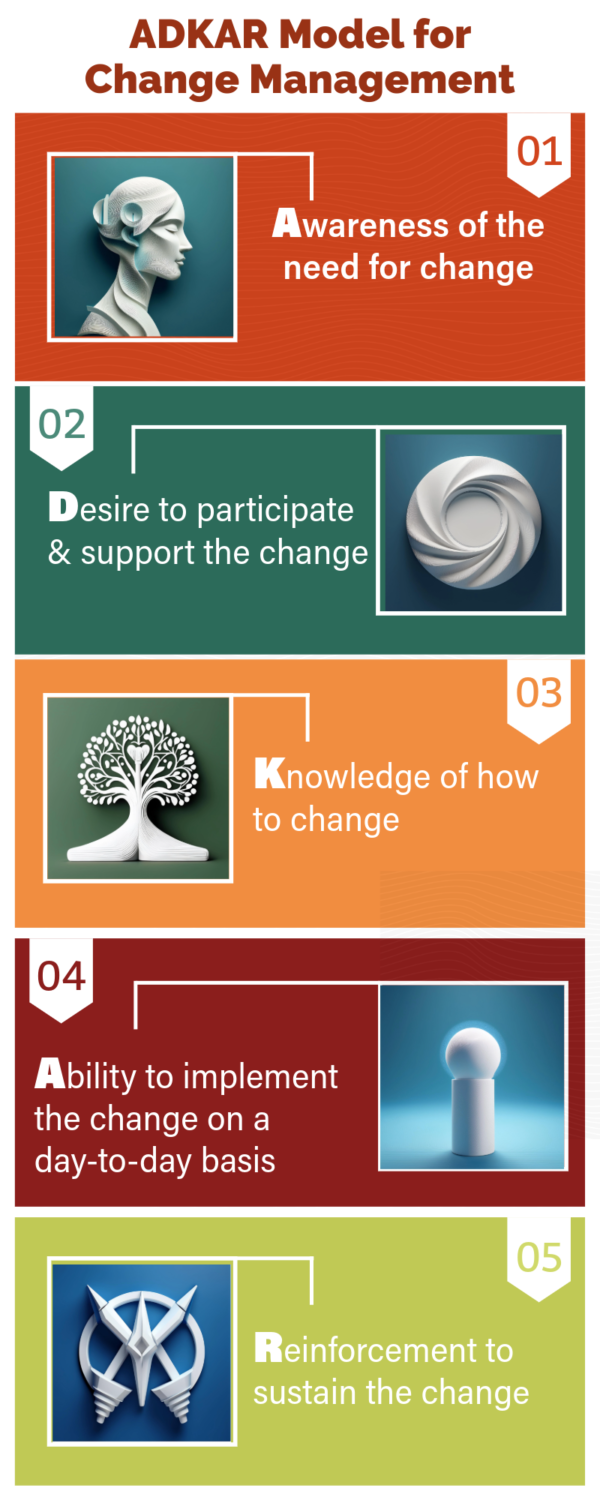
ADKAR Model for Change Management
Leader Toolbox: Understanding and Applying the ADKAR Model for Change Management
The ADKAR model provides a structured approach to managing change, ensuring that both the individual and organizational aspects are addressed. By integrating ADKAR into your management style, you can guide your team through changes—big and small—more effectively, ensuring higher adoption rates and minimizing resistance. Whether you’re a new manager or a seasoned leader, mastering the ADKAR model will equip you with the tools to navigate the complexities of change management successfully.
What is the ADKAR Model?
The ADKAR model, developed by Jeff Hiatt, is a goal-oriented change management model that allows leaders to focus on the key milestones that individuals need to achieve for successful change. ADKAR stands for:
- Awareness of the need for change
- Desire to participate and support the change
- Knowledge of how to change
- Ability to implement the change on a day-to-day basis
- Reinforcement to sustain the change
By breaking down the change process into these five elements, the ADKAR model ensures that leaders can identify and address individual needs, ultimately leading to a smoother transition and greater adoption of new processes or behaviors.
How to Integrate ADKAR into Your Management Style
1. Awareness: Communicate the Why
Start by ensuring that your team understands why the change is necessary. This step involves clear and consistent communication. For example, if you are introducing a new project management tool, explain how it will help streamline processes, reduce bottlenecks, and ultimately make their work easier. Use meetings, emails, and one-on-one conversations to reinforce the message, ensuring that everyone is aware of the reasons behind the change.
Common Pitfalls:
- Assuming Awareness Equals Understanding: Don’t assume that just because you’ve announced the change, everyone fully understands why it’s necessary. It’s crucial to communicate not just the what but the why behind the change.
- Inadequate Communication Channels: Relying solely on emails or memos can lead to misunderstandings. Use a mix of communication methods, including meetings, one-on-one conversations, and visual aids.
2. Desire: Address Concerns and Motivate
Once awareness is established, the next step is to cultivate a desire for change. This can be challenging as it involves overcoming resistance. To foster desire, involve your team in the change process by seeking their input and addressing their concerns. For example, if employees are worried about the learning curve of new software, offer assurances such as training sessions or extra support during the transition period. Highlight the benefits of the change for both the organization and the individuals involved.
Common Pitfalls:
- Ignoring Resistance: Assuming that everyone will automatically buy into the change is a mistake. Resistance is natural and should be addressed early.
- Overlooking Individual Motivations: Different team members have different motivations. What drives one person might not resonate with another.
3. Knowledge: Provide the Know-How
Knowledge is critical for empowering your team to make the change. Provide the necessary training and resources to ensure everyone knows how to change. For example, if you’re rolling out a new customer relationship management (CRM) system, organize training workshops or provide online tutorials to help your team learn the new tool. Ensure that these resources are easily accessible and that there is a clear path for employees to ask questions and seek additional help.
Common Pitfalls:
- Inadequate Training: Skimping on training or assuming that a one-size-fits-all approach will work can lead to frustration and failure.
- Information Overload: Dumping too much information on your team at once can overwhelm them, leading to confusion rather than clarity.
4. Ability: Facilitate Skill Development
Even with the right knowledge, your team needs to develop the ability to implement the change effectively. This might involve practice, coaching, or additional resources to build competence. For example, if a team member is struggling to use the new CRM system effectively, pair them with a colleague who is more proficient, or provide one-on-one coaching sessions. The goal here is to ensure that your team can perform their duties using the new methods or tools.
Common Pitfalls:
- Assuming Knowledge Equals Ability: Just because someone knows what to do doesn’t mean they can do it effectively right away. Practice and support are essential.
- Overlooking Individual Differences: People learn and adapt at different paces. Ignoring this can lead to uneven adoption and frustration.
5. Reinforcement: Sustain the Change
The final step in the ADKAR model is reinforcing the change to prevent backsliding. This involves monitoring the change, celebrating successes, and addressing any issues that arise after the change has been implemented. For instance, after implementing the new CRM system, you could set up regular check-ins to discuss how the tool is being used, celebrate milestones, and make any necessary adjustments. Reinforcement might also include integrating the new processes into performance evaluations or offering incentives for successful adoption.
Common Pitfalls:
- Neglecting Follow-Up: Assuming that once the change is made, it will stick without further effort is a common mistake.
- Failing to Celebrate Successes: Not recognizing and rewarding progress can lead to backsliding as people revert to old habits.
The ADKAR model provides a structured approach to managing change, ensuring that both the individual and organizational aspects are addressed. By integrating ADKAR into your management style, you can guide your team through changes—big and small—more effectively, ensuring higher adoption rates and minimizing resistance. Whether you’re a new manager or a seasoned leader, mastering the ADKAR model will equip you with the tools to navigate the complexities of change management successfully.
Final Thought: This model not only helps managers lead their teams through change but also serves as a valuable tool for self-reflection. When managers find themselves struggling with change, it’s crucial to assess which ADKAR element might be missing for themselves. Identifying gaps in awareness, desire, knowledge, ability, or reinforcement can help overcome personal challenges with change just as effectively as it helps teams.
AIG




